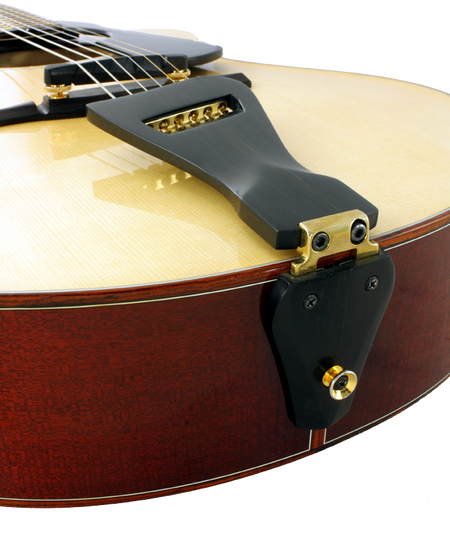-
Here is a shot of an adjustable tailpiece on my Comins Zelig archtop. Not only can it be adjusted up and down to adjust the break angle and down pressure on the saddle/bridge but also side to side to vary the pressure across the strings.

-
01-11-2024 08:35 PM
-
Here is a shot of an adjustable tailpiece on my Comins Zelig archtop. Not only can it be adjusted up and down to adjust the break angle and down pressure on the saddle/bridge but also side to side to vary the pressure across the strings.

-
[QUOTE=zephyrregent;1309544]
Thanks. That helps. Originally Posted by skykomishone
Originally Posted by skykomishone
My only complaint about my Trenier is that his tailpiece buries the endpin jack because the tailpiece is thick at the bottom, and thus making it nearly impossible to put your strap on it. It seems like he puts the jack in first, then the tailpiece, because the jack is not given enough relief for the strap. I had to go inside the guitar and back off the retainer quite a bit to expose the jack beyond the TP. Great guitar. Solid tailpiece. I expect I'm not the only one that's had that problem. I love the guitar.
-
[QUOTE=zephyrregent;1309544]
I have moved the tailpiece down a little more - the point is indeed sticking out but it does not bother me one bit, it's all good. Originally Posted by skykomishone
Originally Posted by skykomishone
If need be I could file off the point without consequences.
-
[QUOTE=gitman;1309829]
Thanks. I'm glad it's not a "point" of contention. I'm nervous about doing anything with this guitar but it seems like a simple adjustment. Do you just loosen the strings, loosen the screws and adjust the position of the tailpiece and then tighten it? It does have a soft tone. When I first got it I was impressed that the tone control was all the way up and the treble didn't bother me at all, unlike my L5C with pickups someone added. Not a negative comment about the L5, it's my hearing. I keep the tone on the Trennier with an FHC pickup between all the way up and rolled off some. Originally Posted by zephyrregent
Originally Posted by zephyrregent
-
My own Jazz Special also has a basically mellow tone but it's by no means weak : it has a strong fundamental content and depending on the type and gauge of strings it rings out loud and proud when pushed,
quite surprising for a 16" lam-top guitar. I like the fact that the guitar does not produce too many overtones/brilliance and that the electric tone (it's the main purpose, right ?) is smooth and nicely sustaining.
The guitar originally came with a KA single coil floater (tapped) which was subsequently swapped for a full-size tapped single coil (on a home-made pickguard). The tapped output gives me a sightly lower volume but brighter tone which is very useful for old-style comping, activated via a push/pull volume pot.
-
This is likely not news to anyone - 5 strings such as Gibson Mastertones have always had adjustable tailpiece to lower or raise the attachment points of the strings. With their somewhat flexible tops the difference is dramatic between high and low positions. Adjusting the tail piece pressure on the bridge saddle, along with using a thinner tapered or thicker saddle, is commonly how a player dials in sharper or softer sound.
-
It's the same idea behind this unit - the VERY old Oettinger Banjo tailpiece, designed in the 20's :
I use the 4-string version by Lyndon on my OME Plectrum banjo and it's the bee's knees.
ABM 1500g Gold Finger-Saitenhalter
-
Hey Wzp. Wondering if you got to where you were trying to go, and what you might've learned about TP height along the way...
 Originally Posted by wzpgsr
Originally Posted by wzpgsr
-
I’ll probably have the tech take a stab when I have some other work done on the guitar at some point in the future.
 Originally Posted by ccroft
Originally Posted by ccroft
-
We're experimenting with an adjustable fulcrum in a Sacconi style tailpiece. A piece of black buffalo horn 0.125" thickness x 0.380" height x 1.100" length serves as fulcrum insert. It can be adjusted from above by means of two set screws from depth of 0.010" - 0.250" to change break angle to bridge by up to 4° variance.
Prototypes are purple heart. Permanent one will be black ebony, since much tighter grain will allow for a more delicate, lighter weight carved tailpiece (much like cello tailpiece)Last edited by ArchieHollow; 03-25-2024 at 11:42 AM.




 Reply With Quote
Reply With Quote



Group improvisation
Today, 09:13 AM in Improvisation